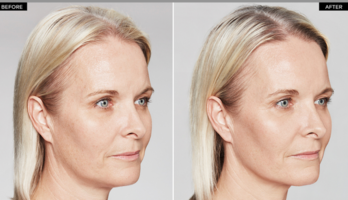For a youthful, firmer you, ask for Sculptra®
Sculptra activates the power of your skin by revitalizing collagen production.¹ With Sculptra, you will renew skin thickness and firmness and correct shallow to deep wrinkles and folds.² Sculptra gradually builds the foundations of the youthful, firmer you, day after day.³

Why Sculptra?
Sculptra activates the skin’s ability to produce collagen, restoring the skin’s structure and renewing its natural firmness.4 Collagen is a fibrous protein in the deeper layers of your skin and is key in making your skin look young and healthy. As you age, your body’s collagen production decreases. The loss of collagen will in time lead to loose and saggy skin and the formation of facial wrinkles and folds.5
Sculptra is the original collagen stimulator that will renew your skin in a gradual and long-lasting way by stimulating collagen production.6 Sculptra gives you control of your skin and the power to look as great as you feel.
TREATMENT AREAS
Sculptra brings volume and firmness to areas of your face that have become loose and saggy.7 Examples include smile lines (also called nasolabial folds), laugh lines (or marionette lines) and chin wrinkles. The treatment helps gradually replace lost collagen and results may last for more than two years.8 Sculptra will reinvigorate your skin and bring back your youthful appearance.
80% of users were still satisfied with their Sculptra treatment 25 months after their last injection, according to a clinical study.9



Your Sculptra treatment
Sculptra is injected in the deep layers of your skin to stimulate its own collagen production.10 You will gradually notice visible improvements of skin firmness and fullness, and results can last for more than two years.11 On average, three treatment sessions are needed over a few months.
Immediately after each treatment session, you may experience some swelling that will temporarily reduce wrinkles and folds. Thereafter, the gradual process of collagen replacement starts. Sculptra works subtly, improving facial areas gradually to give you a youthful and natural-looking result that lasts.

How it works
The active ingredient in Sculptra is poly-L-Lactic acid, PLLA. PLLA is a biodegradable substance that has been used for decades in dissolvable stitches for wound management. When PLLA is injected in the deeper layers of your skin, it helps stimulate your skin’s own natural collagen production.12 Thereby, your skin’s inner structure is improved and you will regain skin volume that has been lost to aging.13

80% RATED SCULPTRA AS GOOD TO EXCELLENT AFTER 25 MONTHS14
100% of patients would recommend Sculptra to a friend15
Proven aesthetic results since 199916
FREQUENTLY ASKED QUESTIONS
How should I prepare before my consultation?
Before your first treatment you will always have a consultation. Think through what you want to achieve and any questions that you want to ask your healthcare practitioner. You will be informed about how Sculptra works and how it can be used in a safe way to improve your skin’s firmness by stimulating your body’s own collagen production.
Your healthcare practitioner will also ask you about your medical history. After the consultation you should feel well informed about Sculptra and know what results to expect.
What should I think about when choosing a clinic?
Make sure that the clinic has a qualified practitioner(s) so that your treatment will be performed correctly. You could always search in national registers of licensed aesthetic treatment specialists. Your treatment should be performed in a medical environment that provides privacy and is spotlessly clean. You can always request to see training certificates and insurance certificates to ensure that your healthcare practitioner has received the appropriate training and is insured for the treatment.
Who can inject Sculptra?
Specialists who have been trained to inject Sculptra for natural collagen stimulation, and are licensed to practice within your country or state, may administer the treatment. This can include physician assistants, nurse practitioners, registered nurses and other trained personnel.
What should I expect from my chosen healthcare practitioner?
Your healthcare practitioner should provide you with comprehensive information about how Sculptra can stimulate the formation of collagen in a natural way and give you a detailed explanation regarding your treatment.
This is what you should expect:
• Information about the possibilities and limitations of the treatment
• Information about possible side effects and precautions for treatment
• Information about the cost of the treatment and follow-up treatments
• That your questions are answered to your full satisfaction
Which areas does Sculptra treat?
Sculptra is injected to correct shallow to deep wrinkles and folds, by stimulating the skin’s own collagen production. Administered with the appropriate injection technique from a trained specialist, Sculptra is clinically approved for:
• Deep folds between the nose and mouth (nasolabial folds), also called “smile lines”
• Lines framing the mouth (marionette lines)
• Chin wrinkles
Please note that indications vary between countries. Please consult your healthcare practitioner for more information.
How many treatments are required?
On average, a series of three treatment sessions over the course of a few months may be needed. The number of injections at each session will vary, depending on the degree of correction needed and the treatment plan determined by you and your healthcare practitioner.
Skin insights
Are you looking for a clinic?
OUR PORTFOLIO OF PRODUCTS
Galderma has developed a diverse portfolio of products that work holistically together.
REFERENCES
1 Stein P et al. J Dermatol Sci 2015;78(1):26–33.; Goldberg D et al. Dermatol Surg 2013;39(6):915–22.; Moyle GJ et al. HIV Med 2004;5(2):82–7.
2 Nelson L and Stewart KJ. J Plast Reconstr Aesthet Surg 2012;65(4):439–47.; Moyle GJ et al. HIV Med 2004;5(2):82–7.; Mest DR and Humble G. Dermatol Surg 2006;32(11): 1336–45.; Valantin MA et al. AIDS 2003;17(17):2471–7.; Narins RS et al. J Am Acad Dermatol 2010;62(3):448–62.; Brandt FS et al. Aesthet Surg J 2011;31(5):521–8.
3 Stein P et al. J Dermatol Sci 2015;78(1):26–33.9.; Goldberg D et al. Dermatol Surg
2013;39(6):915–22.; Vleggaar D et al. J Drugs Dermatol 2014;13(4 suppl):s29–31.;
Moyle GJ et al. HIV Med 2004;5(2):82–7.; Bohnert K et al. Plast Reconstr Surg
2019;127(4):1684–92
4 Stein P et al. J Dermatol Sci 2015;78(1):26–33.9.; Goldberg D et al. Dermatol Surg 2013;39(6):915–22.; Vleggaar D et al. J Drugs Dermatol 2014;13(4 suppl):s29–31.; Moyle GJ et al. HIV Med 2004;5(2):82–7.
5 Fisher GJ et al. Arch Dermatol 2008;144(5):666–72.; Werschler WP et al. J Clin Aesthet Dermatol 2015;8(10 Suppl):S2–S7.
6 Stein P et al. J Dermatol Sci 2015;78(1):26–33.9.; Goldberg D et al. Dermatol Surg 2013;39(6):915–22.; Vleggaar D et al. J Drugs Dermatol 2014;13(4 suppl):s29–31.; Moyle GJ et al. HIV Med 2004;5(2):82–7.
7 Stein P et al. J Dermatol Sci 2015;78(1):26–33.9.; Goldberg D et al. Dermatol Surg 2013;39(6):915–22.; Vleggaar D et al. J Drugs Dermatol 2014;13(4 suppl):s29–31.; Moyle GJ et al. HIV Med 2004;5(2):82–7.
8 Narins RS et al. J Am Acad Dermatol 2010;62(3):448–62.; Brandt FS et al. Aesthet Surg J 2011;31(5):521–8.
9 Brown SA et al. Plast Reconstr Surg 2011;127(4):1684–92.
10 Stein P et al. J Dermatol Sci 2015;78(1):26–33.; Goldberg D et al. Dermatol Surg 2013;39(6):915–22.; Moyle GJ et al. HIV Med 2004;5(2):82–7.
11 Brown SA et al. Plast Reconstr Surg 2011;127(4):1684–92.
12 Stein P et al. J Dermatol Sci 2015;78(1):26–33.; Goldberg D et al. Dermatol Surg 2013;39(6):915–22.; Moyle GJ et al. HIV Med 2004;5(2):82–7.
13 Stein P et al. J Dermatol Sci 2015;78(1):26–33.; Goldberg D et al. Dermatol Surg 2013;39(6):915–22.; Moyle GJ et al. HIV Med 2004;5(2):82–7.; Nelson L and Stewart KJ. J Plast Reconstr Aesthet Surg 2012;65(4):439–47.; Mest DR and Humble G. Dermatol Surg 2006;32(11): 1336–45.; Valantin MA et al. AIDS 2003;17(17):2471–7.; Narins RS et al. J Am Acad Dermatol 2010;62(3):448–62.; Brandt FS et al. Aesthet Surg J 2011;31(5):521–8.; Chen HH et al. JAMA Facial Plast Surg 2015;17(1):39–43.
14 Brown SA et al. Plast Reconstr Surg 2011;127(4):1684–92.
15 Mest DR and Humble G. Dermatol Surg 2006;32(11):1336–45.
16 Sculptra was developed and CE approved for aesthetic use in the European market in 1999.





